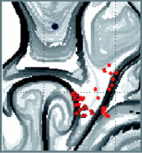Birds track ocean eddies
Image of the Month - September 2009
Filament structures on the 2003-09-24 and 2003-10-6 weeks in the Mozambique Channel, with great frigates locations (colors correspond to different birds; two different kinds of structures can be computed for the same time span). Most of the points can be seen overlaying the darker structures, i.e. the filaments. (Credits IRD)
It seems that satellites are not the only ones tracking eddies from the sky. Great frigates are sea birds, feeding mainly on fishes and squids. When comparing their paths (located by Argos beacons) and ocean dynamics, close correlation can be seen.
Phytoplankton is often found at the border of eddies, and/or on features like the filaments, where vertical mixing is occuring. So animals feeding on this plankton are located around the same areas, and so on, up to the predators, big fishes like tuna, or sea birds like great frigates. Great frigates fly over the edges of filaments more than two thirds of the time, even if such structures do not spread over more than 30% of the ocean. However, the fact that birds, living outside the waters, are able to follow ocean features is a bit more surprising than for marine animals. Atmospheric currents occuring over ocean dynamic features and/or visual or olfactive senses are probably involved.
Classical altimetry has already permitted to spot such correlations. With new techniques such as filament computations, that enable to exploit altimetry data at a higher resolution, a more accurate view is possible.
See also:
- Image of the Month, March 2006: A long way to paddle home for a green turtle
- Image of the Month, October 2008: Thread-like structures extracted from altimetry
References
- Tew Kai, E., V. Rossi, J. Sudre, H. Weimerskirch, C. Lopez, E. Hernandez-Garcia, F. Marsaca, V. Garçon, 2009: Top marine predators track Lagrangian coherent structures, Proceedings of the National Academy of Science, vol. 106, n° 20, pp. 8245-8250








